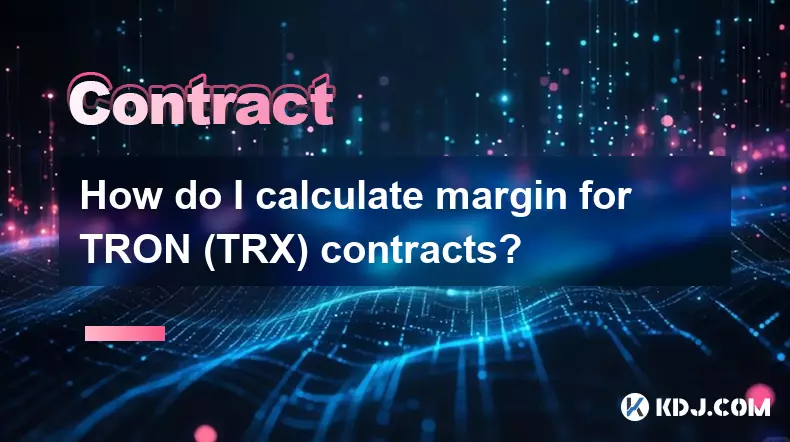-
 bitcoin
bitcoin $122090.672462 USD
1.59% -
 ethereum
ethereum $4493.758974 USD
0.56% -
 xrp
xrp $3.033145 USD
0.65% -
 tether
tether $1.000629 USD
0.00% -
 bnb
bnb $1169.854250 USD
7.07% -
 solana
solana $230.954786 USD
-0.19% -
 usd-coin
usd-coin $0.999785 USD
0.00% -
 dogecoin
dogecoin $0.256108 USD
-1.12% -
 tron
tron $0.342333 USD
-0.12% -
 cardano
cardano $0.859632 USD
-0.10% -
 hyperliquid
hyperliquid $48.932146 USD
-2.25% -
 chainlink
chainlink $22.345466 USD
-1.29% -
 ethena-usde
ethena-usde $1.000217 USD
-0.03% -
 avalanche
avalanche $31.203456 USD
1.93% -
 sui
sui $3.579145 USD
1.05%
How do I calculate margin for TRON (TRX) contracts?
In TRON futures trading, margin acts as collateral for leveraged positions, with initial and maintenance margins determining position entry and liquidation risks.
Sep 30, 2025 at 11:00 am

Understanding Margin in TRON (TRX) Futures Contracts
Margin in TRON futures trading refers to the collateral required to open and maintain a leveraged position. Unlike spot trading, where you purchase assets outright, futures contracts allow traders to gain exposure to price movements using borrowed capital. The margin acts as a security deposit to cover potential losses on the trade. Exchanges that support TRX derivatives typically offer various leverage levels, such as 5x, 10x, or even higher, which directly influence the margin needed.
There are two primary types of margin: initial margin and maintenance margin. The initial margin is the amount required to open a position, calculated based on the contract size, leverage, and current market price. Maintenance margin is the minimum equity that must be maintained in the account to keep the position open. Falling below this threshold triggers a margin call or automatic liquidation.
Traders must monitor their margin balance closely, especially during periods of high volatility, to avoid unexpected liquidations.
- Determine the total value of the TRX futures contract by multiplying the number of contracts by the contract multiplier and the current market price.
- Divide the total contract value by the selected leverage ratio to compute the initial margin requirement.
- Compare the account’s available balance with the initial margin to confirm eligibility for opening the position.
- Track the maintenance margin level, usually expressed as a percentage of the initial margin, to prevent liquidation.
- Account for funding fees if trading perpetual contracts, as these periodic payments can impact net margin over time.
Key Variables Affecting TRX Margin Calculations
The calculation of margin for TRON contracts depends on several dynamic factors that vary between exchanges and contract types. Understanding these variables ensures accurate risk assessment and better trade planning.
Contract size is one of the foundational elements. For example, some platforms define a standard TRX futures contract as representing 100 TRX, while others may use different multipliers. The current market price of TRON directly impacts the notional value of the position and thus the margin needed. Higher prices increase the contract value, demanding more collateral for the same leverage.
Leverage plays a critical role—higher leverage reduces the required margin but increases the risk of liquidation due to smaller adverse price movements.
- Identify the specific contract specifications provided by the exchange, including multiplier and quote currency.
- Use real-time TRX pricing from the exchange’s order book or index feed to calculate notional value.
- Apply the chosen leverage factor to derive the initial margin; for instance, a $1,000 position at 10x leverage requires $100 in margin.
- Check the platform’s maintenance margin rate, which could range from 0.5% to 5% depending on volatility and risk parameters.
- Factor in transaction costs and potential slippage, which indirectly affect usable margin.
Risks Associated with Margin Trading in TRX Derivatives
Trading TRON futures on margin amplifies both profit potential and downside exposure. Rapid price swings in the cryptocurrency market can lead to swift liquidations, particularly when high leverage is used. Liquidation occurs when the account equity drops below the maintenance margin level, resulting in the forced closure of the position at a loss.
Funding rates in perpetual contracts also impact margin sustainability. These rates are paid or received every few hours and depend on the difference between perpetual contract prices and the underlying spot price. In environments where long positions dominate, short traders pay longs, reducing their effective margin over time.
Improper risk management, such as over-leveraging or ignoring stop-loss mechanisms, can lead to complete loss of margin capital.
- Assess historical volatility of TRX to estimate potential price swings and set appropriate leverage.
- Implement stop-loss orders to limit downside exposure and preserve margin balance.
- Avoid holding highly leveraged positions during major news events or exchange upgrades that may spike volatility.
- Regularly review open positions and adjust margin allocation based on changing market conditions.
- Utilize isolated margin mode when available, limiting risk to only the allocated funds per position.
Frequently Asked Questions
What happens when my TRX futures position gets liquidated?Upon liquidation, the exchange automatically closes your position to prevent further losses. Any remaining margin after covering the deficit is returned, though partial or full loss of the initial margin is common.
Can I add more margin to an existing TRX futures position?Yes, most platforms allow margin top-ups, known as margin injection, to increase the buffer against liquidation. This can be done manually through the trading interface.
How does mark price affect margin calculations?The mark price, derived from spot indices and funding rates, is used to determine unrealized PnL and liquidation levels. It prevents manipulation and ensures fair margin assessments during volatile periods.
Is cross-margin safer than isolated margin for TRX contracts?Cross-margin uses the entire account balance to support all positions, which can prevent single-position liquidations but risks total account loss. Isolated margin limits exposure to the allocated amount per trade, offering more control.
Disclaimer:info@kdj.com
The information provided is not trading advice. kdj.com does not assume any responsibility for any investments made based on the information provided in this article. Cryptocurrencies are highly volatile and it is highly recommended that you invest with caution after thorough research!
If you believe that the content used on this website infringes your copyright, please contact us immediately (info@kdj.com) and we will delete it promptly.
- BlockDAG, DOGE, HYPE Sponsorship: Crypto Trends Shaping 2025
- 2025-10-01 00:25:13
- Deutsche Börse and Circle: A StableCoin Adoption Powerhouse in Europe
- 2025-10-01 00:25:13
- BlockDAG's Presale Buzz: Is It the Crypto to Watch in October 2025?
- 2025-10-01 00:30:13
- Bitcoin, Crypto, and IQ: When Genius Meets Digital Gold?
- 2025-10-01 00:30:13
- Stablecoins, American Innovation, and Wallet Tokens: The Next Frontier
- 2025-10-01 00:35:12
- NBU, Coins, and Crypto in Ukraine: A New Yorker's Take
- 2025-10-01 00:45:14
Related knowledge

What is the difference between futures and perpetual contracts for Bitcoin?
Oct 02,2025 at 11:54pm
Understanding Bitcoin Futures Contracts1. Bitcoin futures are derivative instruments that allow traders to speculate on the future price of Bitcoin at...

What is the best time to trade PEPE contracts?
Oct 03,2025 at 11:54am
Understanding PEPE Contract Volatility1. PEPE contracts exhibit extreme price fluctuations due to their meme-based nature and low market cap. Trading ...

What are the common mistakes to avoid with Bitcoincoin contracts?
Oct 03,2025 at 08:54am
Emerging Trends in the Cryptocurrency Market1. Decentralized finance (DeFi) platforms continue to expand their influence across the blockchain ecosyst...

What is the maintenance margin for Bitcoin contracts?
Oct 02,2025 at 01:36am
Decentralized Exchanges Gain Momentum in 20241. Decentralized exchanges (DEXs) have seen a significant rise in trading volume, surpassing centralized ...

How to use technical analysis for trading XRP contracts?
Oct 03,2025 at 01:18pm
Understanding Price Patterns in XRP Futures1. Identifying chart patterns such as triangles, head and shoulders, and double tops or bottoms can provide...

What does "longing" PEPE contracts mean?
Oct 03,2025 at 11:54pm
Understanding Decentralized Exchanges in the Crypto Ecosystem1. Decentralized exchanges (DEXs) operate without a central authority, allowing users to ...

What is the difference between futures and perpetual contracts for Bitcoin?
Oct 02,2025 at 11:54pm
Understanding Bitcoin Futures Contracts1. Bitcoin futures are derivative instruments that allow traders to speculate on the future price of Bitcoin at...

What is the best time to trade PEPE contracts?
Oct 03,2025 at 11:54am
Understanding PEPE Contract Volatility1. PEPE contracts exhibit extreme price fluctuations due to their meme-based nature and low market cap. Trading ...

What are the common mistakes to avoid with Bitcoincoin contracts?
Oct 03,2025 at 08:54am
Emerging Trends in the Cryptocurrency Market1. Decentralized finance (DeFi) platforms continue to expand their influence across the blockchain ecosyst...

What is the maintenance margin for Bitcoin contracts?
Oct 02,2025 at 01:36am
Decentralized Exchanges Gain Momentum in 20241. Decentralized exchanges (DEXs) have seen a significant rise in trading volume, surpassing centralized ...

How to use technical analysis for trading XRP contracts?
Oct 03,2025 at 01:18pm
Understanding Price Patterns in XRP Futures1. Identifying chart patterns such as triangles, head and shoulders, and double tops or bottoms can provide...

What does "longing" PEPE contracts mean?
Oct 03,2025 at 11:54pm
Understanding Decentralized Exchanges in the Crypto Ecosystem1. Decentralized exchanges (DEXs) operate without a central authority, allowing users to ...
See all articles










































































